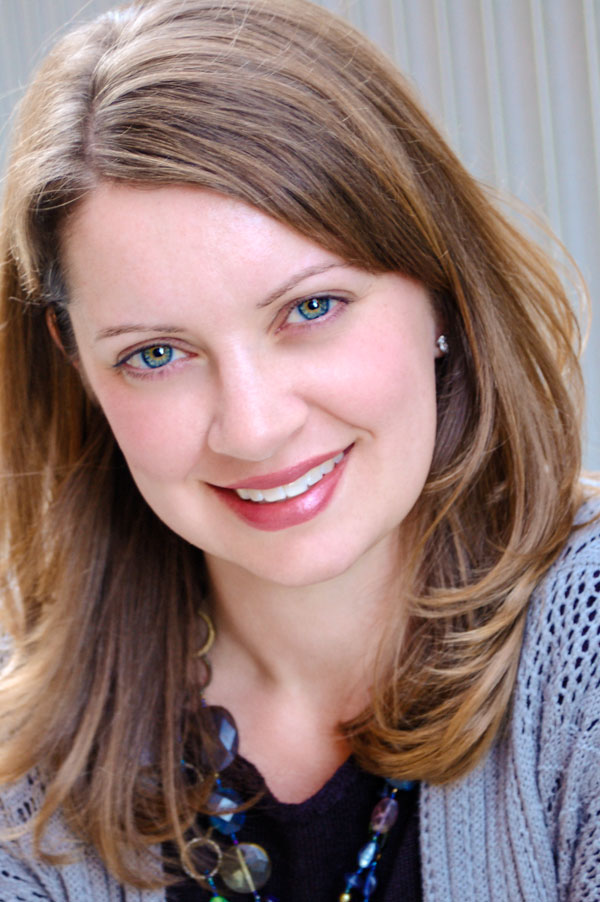
Sunday, April 21, 2024, 3:00 p.m.
Gershwin Performing Arts Center | Murrieta Mesa High School
Today’s Program
Amy Beach (1867 – 1944)
Arr. Kenneth Atkins
Summer Dreams, Op. 47
1. The Brownies
2. Robin Redbreast
3. Twilight
4. Katy-dids
5. Elfin Tarantellle
6. Good Night
Antonin Dvorak (1841 – 1904)
Serenade for Winds in D Minor, Op. 44, B. 7
1. Moderato quasi marcia
2. Menuetto. Trio.
3. Andante con moto
4. Finale. Allegro molto
INTERMISSION
Ludwig van Beethoven (1770 – 1827)
Symphony No. 2 in D Major, Op 36
1. Adagio molto. Allegro con brio.
2. Larghetto
3. Scherzo. Allegro. Trio.
4. Allegro molto
Thanks to the Murrieta Valley Unified School District for their support of this concert.
About Our Artistic Director and Conductor
Dana Zimbric is marking her 14th season as Artistic Director and Conductor of the California Chamber Orchestra.
In addition to her work with us, she is Music Director of the Classics Philharmonic Orchestra, which performs educational programs for San Diego area students, and recently made her conducting debut with the San Diego Symphony.
Dana’s past conducting experience includes positions with the San Diego Youth Symphony, Avante Chamber Orchestra, Orchestra Nova San Diego, and the University of Wisconsin Chamber and Symphony Orchestras.
An accomplished clarinetist, Dana holds a Bachelor of Music in Clarinet Performance and a Master of Music in Orchestral Conducting from the University of Wisconsin. She lives in San Diego with her husband and two young daughters.
Members of the California Chamber Orchestra
Violin I
Missy Lukin (Concertmaster)
Isaac Allen
Angela Xing
Batya MacAdam-Somer
Violin II
Kenneth Liao (Principal)
Tiffany Modell
Healy Henderson
Victoria Bietz
Viola
Michael Molnau (Principal)
Linda Piatt
Annabelle Terbetski
Cello
Alex Greenbaum (Principal)
Margaret Tait
Elizabeth Brown
Bass
PJ Cinque (Principal)
Flute
Pam Martchev (Principal)
Kate Prestia-Schaub
Oboe
Andrea Overturf (Principal)
Ellen Hindson
Clarinet
Frank Renk (Principal)
Sheryl Renk
Bassoon
Leyla Zamora (Principal)
Ryan Simmons
Horn
Keith Popejoy (Principal)
Darby Hinshaw
Cynthia McGregor
Trumpet
Elizabeth Howard (Principal)
Rachel Allen
Timpani
Beverly Reese Dorcy (Principal)
Orchestra Personnel Manager and Music Librarian
Michael Molnau

California Chamber Orchestra musicians in this concert are members of The American Federation of Musicians, Local 325
Program Notes
American composer Amy Marcy Cheney Beach (1867-1944) was born in New Hampshire and spent her life in New England. Her mother, an amateur singer and pianist, was Beach’s first music teacher. Beach displayed prodigious musical talent very early on. From the age of 6, she had perfect pitch and synesthesia, a condition in which stimuli in one sensory area links to a second sensory area. In Beach’s case, her synesthesia linked musical keys to colors. Beach’s connections between musical keys and colors were consistent throughout her lifetime.
In 1885, at the age of 18, Beach made her Boston Symphony debut as soloist on Chopin’s Concerto in F minor. In 1894, she composed her Symphony in E minor, Op. 32 “Gaelic Symphony” which premiered in Boston in 1896. This symphony was the first work by an American woman to receive international attention.
Beach composed a collection of four-hand piano works called Summer Dreams in 1901. During this time, she was married to a much older doctor whose ideas of Beach’s musical career were both supportive and restrictive. He was supportive in the sense that he understood his wife’s immense talent and encouraged her to grow and become a composer. Restrictive because he did not support Beach performing in public and demanded that any income Beach received from performances or compositions go directly to charity. His traditional views of marriage strictly prohibited Beach from earning her own money.
Beach’s Summer Dreams was inspired by the New England summer landscape. And like many other composers of this time, she relied on textual imagery for each of the movements. The work contains six movements: The Brownies, which references Shakespeare fairies; Robin Redbreast, in the key of G major, which was Beach’s red key; Twilight, inspired by words of her own; Katy-dids, inspired by Walt Whitman; Elfin Tarantelle, using Shakespeare’s words of nighttime fairies; Good Night, inspired by words of Lockhart.
According to the Library of Congress, Beach’s rise to prominence excelled in the second half of her life:
“After her husband’s death in 1910, Beach sailed for Europe to establish her reputation there as both a performer and composer. She received enthusiastic reviews for recitals in Germany and for her symphony and concerto, which were performed in Leipzig and Berlin. She returned to the U.S. in 1914, where she concertized in the winters and composed in the summers. In 1921 she became a fellow at the MacDowell Colony in Peterborough, New Hampshire, where she composed most of her later works.
Beach assumed many leadership positions, often in advancing the cause of American women composers. She was associated with the Music Teachers National Association and the Music Educators National Conference. In 1925, she was a founding member and first president of the Society of American Women Composers. Following her death on December 27, 1944, Beach’s royalties were given to the MacDowell Colony, as prescribed in her will.”
The California Chamber Orchestra performs an arrangement for string orchestra by Kenneth Atkins.
Czech composer Antonin Dvorak (1841-1904) wrote his Serenade for Winds in D minor in the summer of 1878. The piece contains four distinct movements, beginning with a march-like theme. The work showcases the rich, dark, tonal colors of the winds and low strings.
The second movement is a Minuet and Trio with an uplifting and positive mood. Dvorak expertly crafts the wind voicings to best display each instrument’s unique and special abilities. As the movement rolls along, Dvorak displays his ability to create music that is both lyrical and rhythmic, often at the same time, as long phrases of the melody are supported by bass punctuations that are both on and off the beats. The middle Scherzo (“joke”) is fun and lively and serves as an enthusiastic contrast to the Minuet theme.
The third movement is slow but moves along thanks to a syncopated rhythmic heartbeat in the horns. Dvorak is king of melodic material, taking the listener on a journey through darker emotive passages, only to return to lovely melodic fragments of the beginning.
The finale begins with a new strength and energy, with the ensemble in unison. With a nod to the style of a Slavic dance, Dvorak keeps the pace moving forward with energy and vigor. The piece momentarily brings back themes from the slow movement and the opening march and then flies to an exhilarating conclusion in D major.
Ludwig van Beethoven (1770-1827) traveled with his patron Prince Karl Lichnowsky to the countryside in the summers. While there, he would often compose new works in the beautiful surroundings. Beethoven’s second symphony was composed in the summer and fall of 1802. Letters from this time suggest Beethoven was beginning to realize his hearing loss was significant and untreatable. Though he kept this personal information mostly secret, he had started sharing his health information with those closest to him.
“But what a humiliation for me when someone standing next to me heard a flute in the distance and I heard nothing, . . . Such incidents drove me almost to despair, a little more of that and I would have ended my life—it was only my art that held me back. Ah, it seemed to me impossible to leave the world until I had brought forth all that I felt was within me. . . . Patience, they say, is what I must now choose for my guide, and I have done so—I hope my determination will remain firm to endure until it pleases the inexorable Parcae to break the thread. . . . Forced to become a philosopher already in my 28th year, . . . Divine One, thou seest my inmost soul, thou knowest that therein dwells the love of mankind and the desire to do good.” Beethoven in a letter to his brothers known as the Heiligenstadt Testament, written October 1802 as he was finishing Symphony No. 2.
People familiar with Beethoven’s Symphonies may be less familiar with his Second symphony. It never quite caught on like some of his other works– Symphony No. 5 (da-da-da-DUM), Symphony No. 6 (“Pastorale”), or the epic Symphony No. 9 (“Choral”).
However, Beethoven’s Symphony No. 2 in D major is filled with charming and clever surprises. The symphony’s general mood is bright, with moody moments mixed in. Considering Beethoven’s dark personal struggles at the time, it is no wonder that the symphony shows some signs of the composer’s inner turmoil.
The first movement begins with a slow introduction contrasting a short, fanfare-like motive with a lyrical and smooth countertheme. After the introduction, the speed quickens and is filled with nervous excitement and energy.
The second movement marked Larghetto, has a slower tempo and is the second-longest movement of the symphony. Beethoven takes his time developing the melody and utilizes fragments of the first movement themes in the conclusion.
The third movement was a surprise to Beethoven’s contemporaries. Traditionally the third movements of symphonies were minuets, based on a moderate tempo dance in three. Beethoven was looking ahead when he composed a fast scherzo instead, which was certainly too quick to be based on a dance. The movement also has a middle trio section, which keeps the quick pace.
The finale of this movement continues the fast and energetic feeling. The composer asks the orchestra to play “allegro molto” (very fast!) taking the audience on an exciting conclusion.
Beethoven would go on from his second symphony and continue to expand the boundaries of what a symphony could be. Glimpses of his adventurous compositional powers were clearly evident from his second symphony.
— Dana Zimbric
Thank You to Our Sponsors and Donors
Society Sponsors
Judy Call
Prudhomme Associates, CPAs
City of Temecula
Leslie and Joseph Waters
Season Sponsors
Mark Margolin
Nicola Helm & Stephen Ryder
Education Sponsors
Craig Carper, LaPointe Wealth Management
Murrieta Rotary
Concert Sponsors
Susan & Ken Dickson
Walt Fidler
Soloist’s Circle
Kiyoe MacDonald
Concertmaster’s Circle
Terry Kvitky
Kathryn McCarty
Barry Weiss
Rudy Wokoek
Principal’s Circle
John Welniak
Musician’s Circle
Candace Flint
Karen Hartnett
Susan Humphrey
Sarah Ivar
Martha Minkler
Sana Quijada
Join us at The Merc on the 2nd and 4th Sundays of each month for recitals by some of the region’s best musicians. These intimate performances include opportunities to hear from the musicians about their art, their careers, and the music being performed.
Ardor Trio
Linda Piatt, Robie Evans, Leigh Pettit
Today’s Program
Edmund Severn (1862-1942)
Suite for Two Violins
I. Prélude (A La Barcarolle)
II. Danse Serieuse
III. Nocturne
IV. Fête Champêtre
Maurice Ravel (1875 – 1937)
Jeux d’eau (1901)
Intermission
Hans Sitt (1850-1922)
Konzertino, Op. 133
I. Allegro moderato
II. Andante
III. Poco Allegro
Igor Frolov (1937 – 2013)
Divertimento
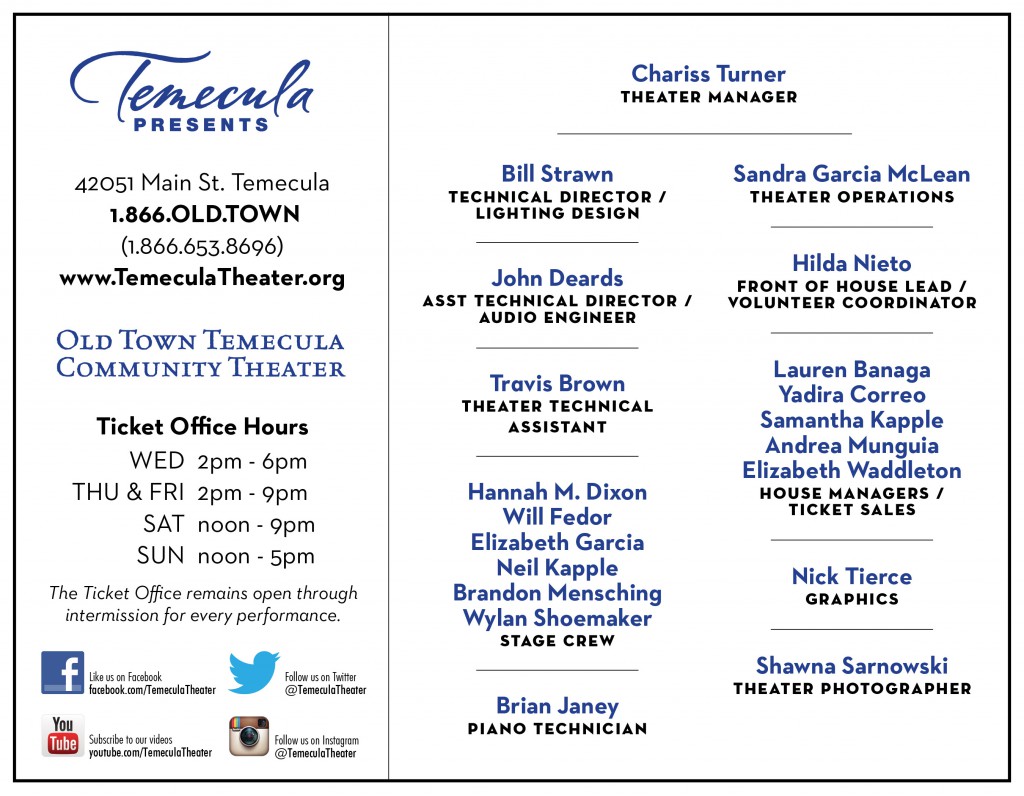

Flûtes de Salon
Valerie McElroy, Cindy Anne Broz, Toni Cortez-Aguilar, Yana Yan
Today’s Program
We’ll Always Have Paris
Flûtes en Vacance – Jacques Castérède (1926 – 2014)
- Flûtes Pastorales
- Flûtes Joyeuses
- Flûtes Rêveuses
- Flûtes Légères
(Valerie McElroy, Cindy Anne Broz, Toni Cortez-Aguilar, Yana Yan, flutes)
Nymphs – Gary Schocker (b. 1959)
- Gathering
- In the Wood
- In the Air
(Yana Yan, Valerie McElroy, Cindy Anne Broz, Toni Cortez-Aguilar, flutes)
Under the Sakura Trees – Momo Sakura (b. 1970)
(Toni Cortez-Aguilar, Yana Yan, Valerie McElroy, Cindy Anne Broz, flutes)
Por Siempre y Para Siempre – Christopher Caliendo (b. 1959)
(Yana Yan and Toni Cortez-Aguilar, flutes)
La Milonga – Christopher Caliendo (b. 1959)
(Valerie McElroy and Cindy Anne Broz, flutes)
The Year of the Rabbit (A Watercolor for 3 C Flutes and Alto Flute) – Daniel Dorff (b. 1956)
(Valerie McElroy, Cindy Anne Broz, Yana Yan, flutes; Toni Cortez-Aguilar, alto flute)
Intermission
Lyric Poem – George Frederick McKay (1899 – 1970)
(Cindy Anne Broz, Valerie McElroy, Toni Cortez-Aguilar, Yana Yan, flutes)
Coffee Nerves – Gary Schocker (b. 1959)
(Toni Cortez-Aguilar, Valerie McElroy, Yana Yan, Cindy Anne Broz, flutes)
A Gaelic Offering – Catherine McMichael (b. 1954)
- Rose Cottage
- The Doubtful Wife – A Reel
- Lake Solace
- ‘Describe a Circle’ – A Jig
(Yana Yan, flute and piccolo; Toni Cortez-Aguilar, Valerie McElroy, Cindy Anne Broz, flutes)
Musetta Steps Out – Daniel Dorff (b. 1956)
(Cindy Anne Broz, piccolo; Yana Yan, c flute; Valerie McElroy, alto flute; Toni Cortez-Aguilar, bass flute)

Batya MacAdam-Somer, violin, viola, and voice
Christopher Adler, khaen
Today’s Program
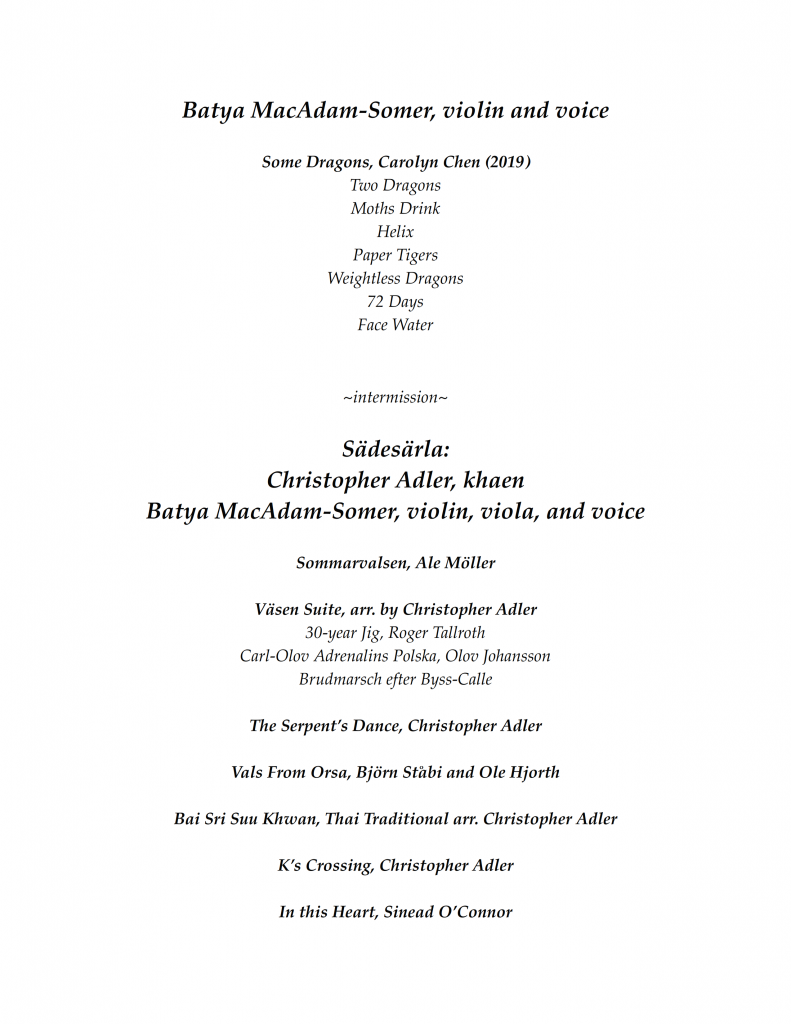

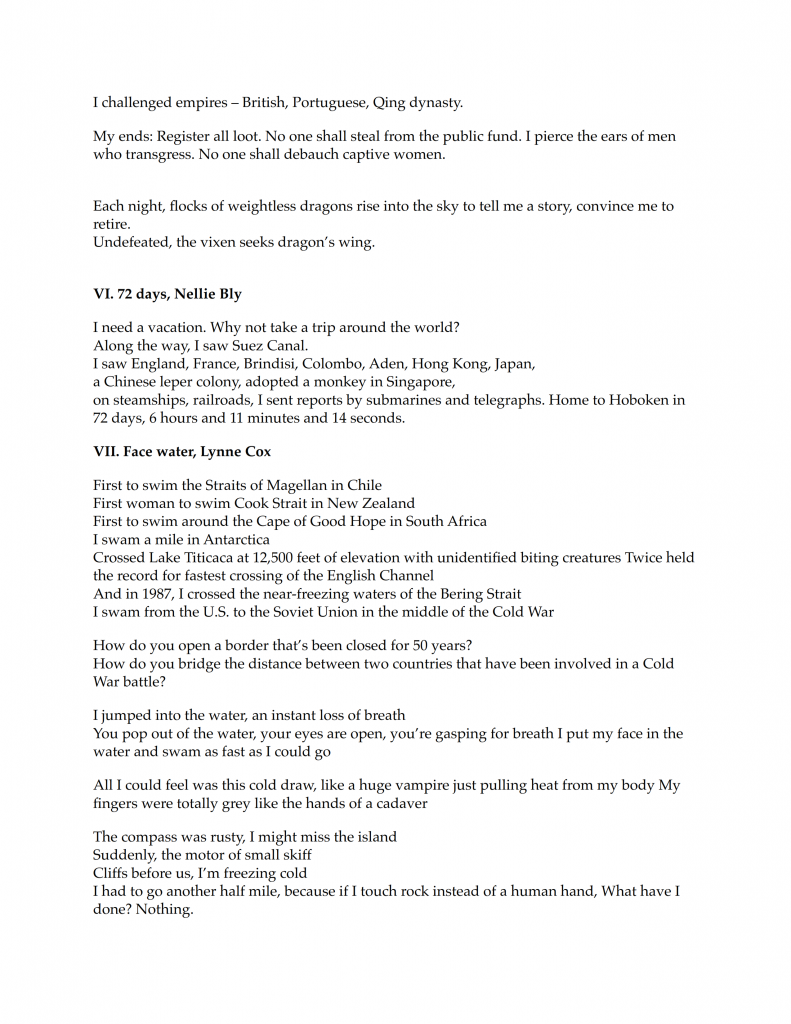
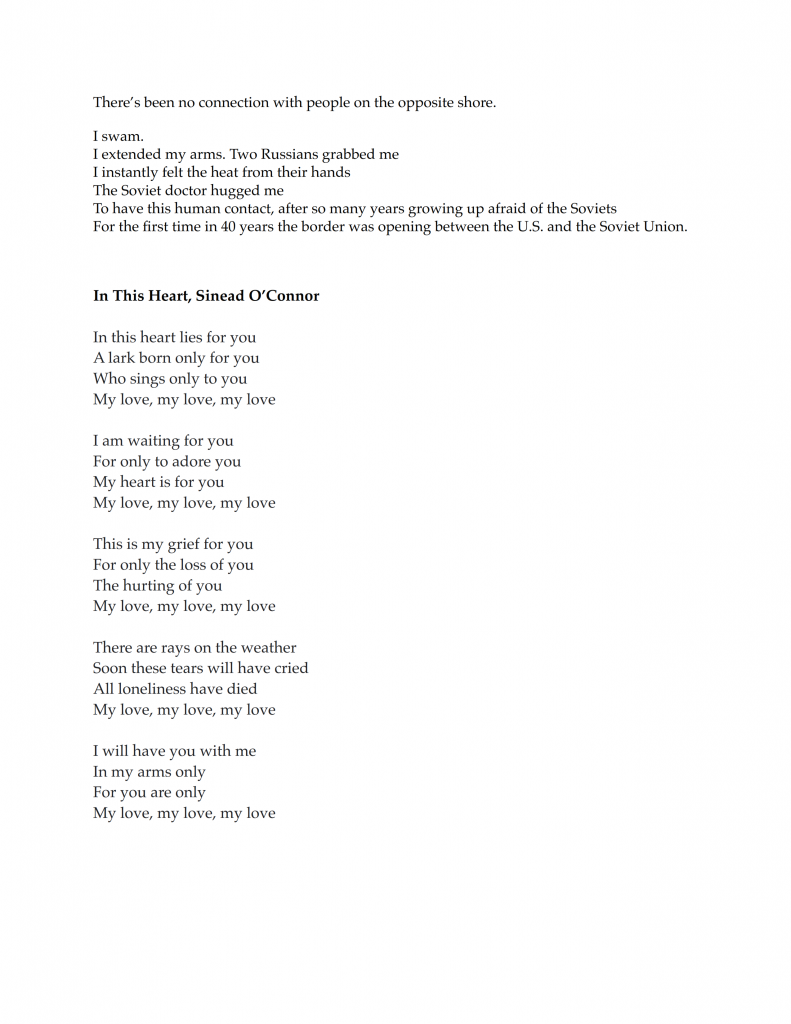

Camarada Tango Quartet
Today’s Program
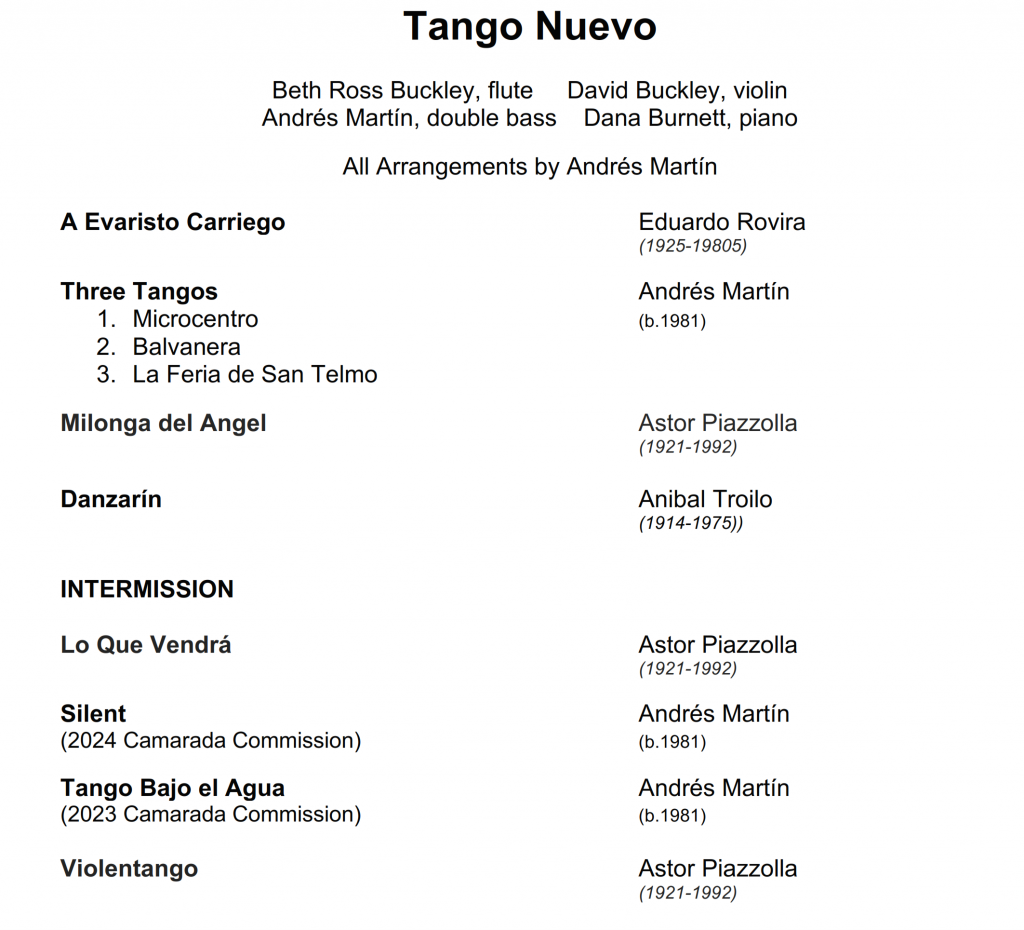

Aviara Trio
Robert Schumitzky, violin; Erin Breene, cello; Inez Irawati, piano
Today’s Program
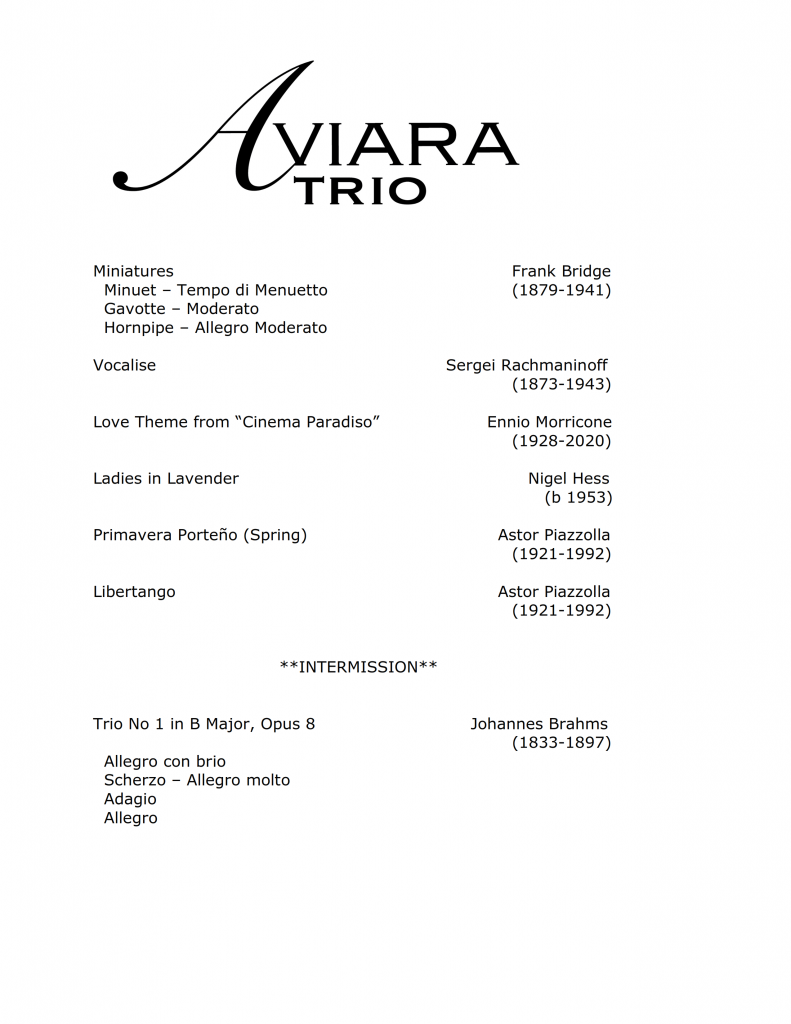


Sunday, February 4, 2024, 3:00 p.m.
Gershwin Performing Arts Center | Murrieta Mesa High School
Today’s Program
Malcolm Arnold (1921 – 2006)
Sinfonietta No. 1, Op. 48 (1954)
1. Allegro comodo
2. Allegretto
3. Allegro con brio
Sally Beamish (b. 1956)
Hover (2018)
Franz Joseph Haydn (1732 – 1809)
Concerto in D Major for Cello and Orchestra
1. Allegro moderato
2. Adagio
3. Allegro
Andrew Hayhurst, cello
INTERMISSION
Franz Joseph Haydn
Symphony No. 95 in C Minor
1. Allegro moderato
2. Andante cantabile
3. Menuetto. Trio.
4. Finale. Vivace.
Thanks to the Murrieta Valley Unified School District for their support of this concert.
About our Soloist
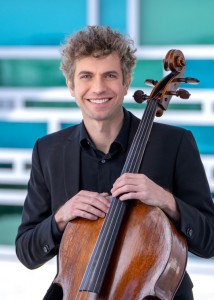 Cellist Andrew Hayhurst holds Bachelor’s degrees in Cello Performance and Performing Arts Technology from the University of Michigan where he received a full merit scholarship and graduated with highest honors. He earned his Master of Music in 2013 from the Yale School of Music.
Cellist Andrew Hayhurst holds Bachelor’s degrees in Cello Performance and Performing Arts Technology from the University of Michigan where he received a full merit scholarship and graduated with highest honors. He earned his Master of Music in 2013 from the Yale School of Music.
After graduating from Yale, Mr. Hayhurst performed regularly with the Los Angeles Opera and Los Angeles Philharmonic, including their 2015 Asia tour with Gustavo Dudamel. He also recorded in many of Hollywood’s major studios and was the Associate Principal Cello of the San Bernardino Symphony. Andrew Hayhurst joined the San Diego Symphony Orchestra in 2015.
As a chamber musician Mr. Hayhurst has collaborated with members of the Chamber Music Society of Lincoln Center and the Los Angeles Philharmonic, and he has been coached by members of the Tokyo, Juilliard, Concord and Emerson Quartets. While at the University of Michigan he formed a piano trio that won the Midwest and Michigan MTNA Chamber Music Competitions in 2010. He has participated in the Kneisel Hall Chamber Music Festival, the Geneva Music Festival and the Schleswig-Holstein Music Festival.
Mr. Hayhurst has performed over National Public Radio and on Los Angeles’s KMozart. He has been awarded scholarships from the Colburn School of Performing Arts and the Santa Barbara Fé Bland Foundation. His primary teachers have been Richard Aaron, Robert deMaine, Aldo Parisot and Richard Naill.
About Our Artistic Director and Conductor
Dana Zimbric is marking her 14th season as Artistic Director and Conductor of the California Chamber Orchestra.
In addition to her work with us, she is Music Director of the Classics Philharmonic Orchestra, which performs educational programs for San Diego area students, and recently made her conducting debut with the San Diego Symphony.
Dana’s past conducting experience includes positions with the San Diego Youth Symphony, Avante Chamber Orchestra, Orchestra Nova San Diego, and the University of Wisconsin Chamber and Symphony Orchestras.
An accomplished clarinetist, Dana holds a Bachelor of Music in Clarinet Performance and a Master of Music in Orchestral Conducting from the University of Wisconsin. She lives in San Diego with her husband and two young daughters.
Members of the California Chamber Orchestra
Violin I
Missy Lukin (Concertmaster)
Angela Xing
Lynne-Marie Friedrichs
Violin II
Tiffany Modell (Principal)
Steve Huber
Randy Brinton
Healy Henderson
Viola
Michael Molnau (Principal)
Annabelle Terbetski
Greg Perrin
Cello
Margaret Tait (Principal)
Elizabeth Brown
Erica Erenyi
Bass
Kevin Gobetz (Principal)
Flute
Beth Ross Buckley (Principal)
Oboe
Andrea Overturf (Principal)
Ellen Hindson
Bassoon
Ryan Simmons (Principal)
David Savage
Horn
Tricia Skye (Principal)
Mike McCoy
Trumpet
Ray Nowak (Principal)
Jeff Nevin
Timpani
Beverly Reese Dorcy (Principal)
Orchestra Personnel Manager and Music Librarian
Michael Molnau

California Chamber Orchestra musicians in this concert are members of The American Federation of Musicians, Local 325
Program Notes
English composer Sir Malcolm Arnold (1921-2006) entered the Royal College of Music at age 16, studying trumpet with Ernest Hall and composition with Gordon Jacob. At age 20, he was named Principal Trumpet of the London Philharmonic, a post he held for 7 years. Though he was considered one of the great trumpeters of the time, his desire to compose required his full attention. By age 30, he worked exclusively as a composer. Arnold is often included with fellow composers William Walton and Benjamin Britten and is considered among the most influential British composers of the 20th century.
Malcolm Arnold’s Sinfonietta No. 1, composed in 1954, is a three-movement work inspired by the 18th-century divertimento and commissioned by the London-based Neel Boyd Orchestra. Showcasing the composer’s mastery of orchestration and distinctive melodic style, this Sinfonietta is a joyful exploration of rhythm and color, with lively themes and rhythmic vitality that capture the spirit of mid-20th-century British music.
Sally Beamish (b. 1956) is an award-winning English composer and violist. Born in London, Beamish began her music career as a violist with Academy of St Martin in the Fields, London Sinfonietta, and others. Her work in composition has led to many accolades. She was appointed a fellow of the Royal Society of Edinburgh in 2015 and the Royal Swedish Academy in 2022. In 2018, she won the Award for Inspiration at the British Composer Awards, and in 2020, she was
awarded an OBE in the Queen’s birthday honors.
Her composition Hover, composed in 2018, explores the delicate balance between stasis and movement. It was a commission by The Academy of St Martin in the Fields and received its premiere performance in February 2019. About her piece, Beamish writes,
“The piece was initially inspired by Gerald Manley Hopkins’ poem The Windhover, which depicts a falcon wheeling and gliding in the morning air… Hover portrays anticipation and exhilaration as well as melancholy, and is also a response to the beauty and destructiveness of nature.
The piece opens on solo oboe, as if coming from a distance. The two oboes then interlace, hovering above a static string texture. The mood settles into a stillness, out of which emerges the Celtic-inspired lullaby, introduced by the solo viola, which then duets with the oboe. The fiery images which dominate the second part of the poem are depicted by horn flourishes, which stir the music into an unsettled passion. A brief calm follows, which is subverted by the downward swooping – almost violent – string passages. The threatening mood is resolved by a return of the lullaby, combined with the opening hovering theme. A coda marked ‘misterioso’ concludes the piece, with joyous horn interjections.”
Franz Joseph Haydn (1732-1809) is remembered as the “father of the symphony.” For many decades of his career, he worked for the Esterhazy family. This wealthy and influential family employed Haydn as their Kapellmeister (leader and house-composer of their orchestra). Haydn and the orchestra would travel with the family to their two castles and perform original music (composed by Haydn) weekly.
Scholars believe that Haydn’s Cello Concerto in D Major was written for the cellist Anton Kraft, a member of the Esterhazy orchestra, and premiered around 1783. As Haydn biographer H.C. Robbins Landon writes, “the ’cello part was certainly ‘tailor-made’ for Kraft, and all those brilliant technical effects . . . show that this is a typical eighteenth-century attempt on the part of the composer to display the talents, tone, and musicianship of his soloist.”
The concerto is in three movements. The first movement, Allegro moderato, begins with a lovely theme first played by the orchestra and followed by the solo cello. The cello embellishes and flourishes throughout the movement, requiring virtuosic technique.
The second movement is slow and highlights the gentle, cantabile side of the solo cello. This is a moment of music to savor and enjoy.
The third movement is jovial, light, and dance-like. The movement is in a rondo form, meaning the main theme recurs, interspersed by new thematic material. In grand concerto style, Haydn writes double stops and octaves for the soloist and closes the concerto with a thrilling finish.
Haydn was the creator of the symphony as a musical format. Through his immense composing–and perhaps due to practical reasons–Haydn needed a system for his large ensemble pieces. What began as general multi-movement large ensemble pieces became codified works with four distinct movements: the opening in sonata-allegro form, the second a slow movement, the third a trio and minuet form, and the fourth a fast finale. By creating and using this format for his music, Haydn’s work created a whole new world for classical composers, leading directly to the symphonic writing of Mozart, Beethoven, Brahms, and many others.
Toward the later years of Haydn’s career, he twice received permission from the Esterhazy family to travel to London, where he composed his final symphonies (numbers 93-104). These pieces of music, nicknamed the London Symphonies, are masterful works of genius.
One of Haydn’s renowned London Symphonies, Symphony No. 95 in C minor, premiered in April 1791. This dramatic work opens with a striking Sturm und Drang (storm and stress) intensity; the symphony traverses a rich landscape of emotions. Haydn’s mastery of form and orchestration is on full display, making this symphony a compelling journey through the classical era’s expressive possibilities.
The symphony is in four movements, each with its uniqueness. After the first movement’s back and forth between C minor and major, the second movement is all charm. This second movement is slow and contains three variations, the first of which highlights the orchestra cello. The third movement is a traditional minuet and trio, though Haydn makes it seem so easy. The principal cellist in the orchestra gets a big moment in the trio section, as it embellishes and plays against the accompanying pizzicato strings. The final movement is an exciting finish to this classic symphony by the masterful Haydn.
— Dana Zimbric
Thank You to Our Sponsors and Donors
Society Sponsors
Judy Call
Prudhomme Associates, CPAs
City of Temecula
Leslie and Joseph Waters
Season Sponsors
Mark Margolin
Nicola Helm & Stephen Ryder
Education Sponsors
Craig Carper, LaPointe Wealth Management
Murrieta Rotary
Concert Sponsors
Susan & Ken Dickson
Walt Fidler
Soloist’s Circle
Kiyoe MacDonald
Concertmaster’s Circle
Terry Kvitky
Kathryn McCarty
Barry Weiss
Rudy Wokoek
Principal’s Circle
John Welniak
Musician’s Circle
Candace Flint
Karen Hartnett
Susan Humphrey
Sarah Ivar
Martha Minkler
Sana Quijada
Join us at The Merc on the 2nd and 4th Sundays of each month for recitals by some of the region’s best musicians. These intimate performances include opportunities to hear from the musicians about their art, their careers, and the music being performed.
Sonya Schumann, piano
Today’s Program
Joseph Haydn (1732-1809)
Sonata in C minor, Hob. XVI:20
I. (Allegro) moderato
II. Andante con moto
III. Finale, Allegro
Frederic Chopin (1810-1849)
Mazurka in A minor, op. 17, no. 4
Clara Schumann (1819-1896)
Notturno, op. 6, no. 2
William Grant Still (1895-1978)
A Deserted Plantation: Spiritual
Harry T. Burleigh (1866-1949)
From the Southland
I. Through Moanin’ Pines
II. The Frolic
III. In de Col’ Moonlight
IV. A Jubilee
V. On Bended Knees
VI. A New Hiding-Place

Redwood Trio
Lauren Basney, violin; Peter Ko, cello; Byron Chow, piano
Today’s Program
J.S. Bach (1685-1750)
Art of the Fugue
Dmitri Shostakovich (1906-1975)
Trio No.2 in E Minor, Op. 67
Tchaikovsky (1840-1893)
Trio Pathetique in A Minor, Op. 50
Bedrich Smetana (1824-1884), arr. Chow
Z Domoviny, “From my Homeland”


Sunday, November 19, 2023, 3:00 p.m.
Gershwin Performing Arts Center | Murrieta Mesa High School
Today’s Program
Gustav Mahler (1860 – 1911)
Symphony No. 4 in G Major
Tasha Koontz, soprano soloist
- Bedächtig, nicht eilen (deliberate, unhurried)
- In gemächlicher Bewegung, ohne Hast (in measured tempo, unhurried)
- Ruhevoll,poco adagio (calm, somewhat slowly)
- Sehr behaglich (at ease)
This afternoon’s concert will be performed without an intermission.
Thanks to the Murrieta Valley Unified School District for their support of this concert.
About our Soloist
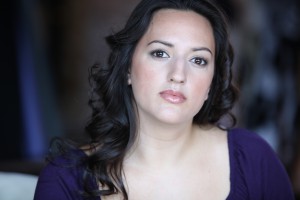 Native Hawaiian soprano Tasha Hokuao Koontz has lent her “accurate, powerful voice” (Broadway World) to a gallery of leading operatic ladies and has been recognized by Parterre Box for her “sumptuous, gleaming lyric instrument” and by Opera Wire for her “secure silvery high notes.”
Native Hawaiian soprano Tasha Hokuao Koontz has lent her “accurate, powerful voice” (Broadway World) to a gallery of leading operatic ladies and has been recognized by Parterre Box for her “sumptuous, gleaming lyric instrument” and by Opera Wire for her “secure silvery high notes.”
In 2024, Tasha will make her South America debut singing the title role of Tosca with Opera Nacional de Chile. In the same year, she returns to San Diego Opera as Donna Anna in Don Giovanni.
In 2023, Tasha joined San Diego Opera to perform the roles of Nella in Gianni Schicchi and Suor Genovieffa in Suor Angelica. A company favorite, Koontz debuted with San Diego Opera as Annina in La Traviata in 2017, and subsequently performed the roles of Edith in Pirates of Penzance, Frasquita in Carmen and High Priestess in Aïda, and covered the role of Mimì in La Bohème sung by Ana Maria Martinez. She also sang the role of Catrina in a 2019 workshop performance of El último sueño de Frida y Diego, written by Pulitzer Prize- winning playwright Nilo Cruz and Latin GRAMMY® Award-winning composer Gabriela Lena Frank. Ms. Koontz subsequently originated the role of Frida Image 1 in the world premiere performances of Frank’s opera in 2022. In San Diego Opera’s 2021 concert entitled, “One Amazing Night,” Koontz “wowed with a knockout performance” (San Diego Union Tribune).
Other 2023 performances include a debut with the Camarada Chamber Ensemble singing Brahms Op.91 Zwei Gesänge and Bach Cantata BWV 209, the Brahms Requiem with the La Jolla Symphony & Chorus, the Rachmaninov Vocalise and Poulenc Gloria with the Helena Symphony, and the world premiere of a two person chamber opera, Her New Home, written by composer Polina Nazaykinskaya and librettist Konstanin Soukhovetski with the prestigious Garth Newel Piano Quartet at the Garth Newel Summer Festival. Ms.Koontz will also return to the Del Mar International Composers’ Symposium in August to continue to bring new music to life with up and coming composers.
Ms. Koontz earned her master’s degree in music from the Jacobs School of Music at Indiana University, where she studied with acclaimed soprano Carol Vaness, and received her bachelor’s degree in music from Northwestern University.
About Our Artistic Director and Conductor
Dana Zimbric is marking her 14th season as Artistic Director and Conductor of the California Chamber Orchestra.
In addition to her work with us, she is Music Director of the Classics Philharmonic Orchestra, which performs educational programs for San Diego area students, and recently made her conducting debut with the San Diego Symphony.
Dana’s past conducting experience includes positions with the San Diego Youth Symphony, Avante Chamber Orchestra, Orchestra Nova San Diego, and the University of Wisconsin Chamber and Symphony Orchestras.
An accomplished clarinetist, Dana holds a Bachelor of Music in Clarinet Performance and a Master of Music in Orchestral Conducting from the University of Wisconsin. She lives in San Diego with her husband and two young daughters.
Members of the California Chamber Orchestra
Violin I
Wes Precourt (Concertmaster)
Violin II
Hanah Suart (Principal)
Viola
Michael Molnau (Principal)
Cello
Andrew Hayhurst (Principal)
Bass
PJ Cinque (Principal)
Orchestra Personnel Manager and Music Librarian
Michael Molnau
Flute
Pam Martchev (Principal)
Oboe
Rodion Bolusov (Principal)
Clarinet
Frank Renk (Principal)
Timpani/Percussion
Beverly Reese Dorcy (Principal)
David Whitman
Piano
Hyemi Kwon (Principal)
Harmonium
Alison Luedecke

California Chamber Orchestra musicians in this concert are members of The American Federation of Musicians, Local 325
Program Notes
Austrian composer Gustav Mahler (1860-1911) wrote his Fourth Symphony in August 1900, amidst a busy symphonic and opera conducting career. Compared to Mahler’s other six symphonies, the 4th is lighter in style, with neoclassical attributes. Though Mahler’s core compositional style is steeped in Romanticism and tonal color, the 4th Symphony has more similarity with Mozart or Haydn than with composers like Brahms or Wagner.
The 4th symphony is considered by many Mahler historians to be an exploration of child-like emotions and experiences. Mahler is known to have had a difficult childhood – he grew up in a household with an abusive father; sickness and death were rampant among his 13 siblings. Mahler never lost touch with his artistic inner child and worked through this childlike lens when composing his 4th symphony.
The first movement immediately transports the listener into a fairy tale setting. Mahler chooses rhythmic sleigh bells that evoke the feeling of traveling by horse-drawn carriage into a magical setting. The melody played by the first violin is hopeful and joyful, answered by a playful clarinet. The movement is filled with moments of musical jokes and has a lively feel.
The second movement takes a much darker turn. Here, Mahler explores the raw emotion of fear. Mahler’s wife, Alma, said Arnold Böcklin’s work entitled Self-Portrait with Death Playing the Fiddle (1872) inspired this second movement. In the portrait, the artist is shown with the violin-playing skeleton of Death lurking over his shoulder and whispering into the artist’s ear. Mahler portrayed violin-playing Death via the Concertmaster’s instrument. Mahler calls for the Concertmaster to have a second violin with scordatura tuning, meaning the strings are tuned very sharp. This gives the violin a scary, haunting, other-worldly sound. During the movement, the Concertmaster switches between their two violins. The music is in a quick three, suggesting a spooky dance with Death.
The third movement starkly contrasts the prior dark music and is celebrated as one of the most beautiful slow movements Mahler ever composed. The movement begins with a heartbeat rhythm and a gorgeous melody played by the cello. Mahler depicts divine love throughout this music. Mahler takes his time in this movement, which lasts nearly 20 minutes. As the movement concludes, Mahler’s score indicates that the gates of heaven open.
According to Mahler, the fourth and final movement is a peek into heaven. It features a soprano soloist who sings a setting of “The Heavenly Life” from The Youth’s Magic Horn, a collection of German folk songs and poems published between 1805 and 1808. The text depicts a childlike angel describing paradise in heaven, where food is plentiful, and music is more beautiful than on Earth. Mahler is careful to say that the song should not be presented as a parody, but in an honest manner. In Mahler’s mind, no one would know heaven better than a child.
This chamber version of Mahler’s 4th Symphony was transcribed in 1921 by conductor, composer, and music teacher Erwin Stein (1885-1958) under his mentor Arnold Schoenberg (1874-1951). Schoenberg and other composers (including Stein, Berg, and Webern) formed an exclusive concert series in Vienna between 1919 and 1921. The concerts were open to members only and explicitly forbade critics (they even posted a sign on the door: ‘Critics forbidden entry.’) The goal of the Society for Private Musical Performances was to perform works by composers from Gustav Mahler (1860-1911) to the present (1919-21) without the worry of ‘old-fashioned’ audiences disapproving of the work, or music critics publishing scathing reviews of the new music. The Society existed to promote new music in a safe, non-judgmental environment, so much in fact, that applause of any kind was also not permitted. No printed programs were created, and the musical selections were not announced until the concert began.
During its few years of existence, the Society held 353 performances. Many of the works in these performances had first to be transcribed for smaller ensembles; the post-WWI economy demanded it. Mahler’s 4th Symphony was one of the many pieces Schoenberg and his colleagues transcribed for smaller ensemble and performed during an exclusive Society concert.
— Dana Zimbric
Text

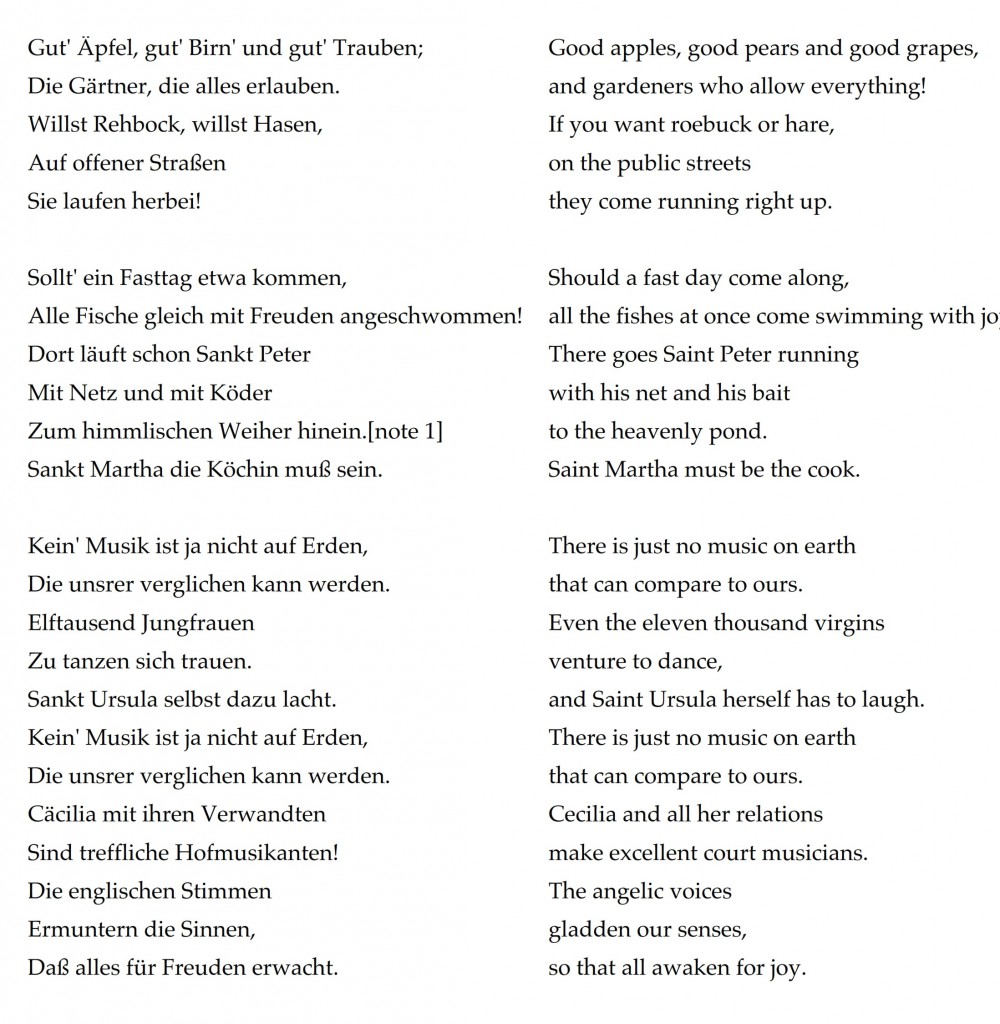
Thank You to Our Sponsors and Donors
Society Sponsors
Judy Call
Prudhomme Associates, CPAs
City of Temecula
Leslie and Joseph Waters
Season Sponsors
Mark Margolin
Nicola Helm & Stephen Ryder
Education Sponsors
Craig Carper, LaPointe Wealth Management
Murrieta Rotary
Concert Sponsors
Susan & Ken Dickson
Walt Fidler
Soloist’s Circle
Kiyoe MacDonald
Concertmaster’s Circle
Terry Kvitky
Kathryn McCarty
Barry Weiss
Rudy Wokoek
Principal’s Circle
John Welniak
Musician’s Circle
Candace Flint
Karen Hartnett
Susan Humphrey
Sarah Ivar
Martha Minkler
Sana Quijada
Join us at The Merc on the 2nd and 4th Sundays of each month for recitals by some of the region’s best musicians. These intimate performances include opportunities to hear from the musicians about their art, their careers, and the music being performed.
Page 1 of 7 1 2 3 4 5 » ... Last »



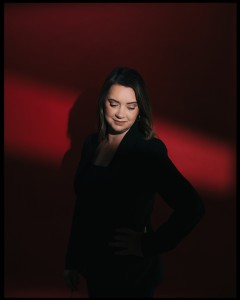
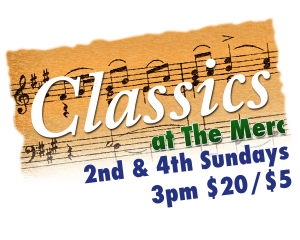








 Cellist Andrew Hayhurst holds Bachelor’s degrees in Cello Performance and Performing Arts Technology from the University of Michigan where he received a full merit scholarship and graduated with highest honors. He earned his Master of Music in 2013 from the Yale School of Music.
Cellist Andrew Hayhurst holds Bachelor’s degrees in Cello Performance and Performing Arts Technology from the University of Michigan where he received a full merit scholarship and graduated with highest honors. He earned his Master of Music in 2013 from the Yale School of Music.
